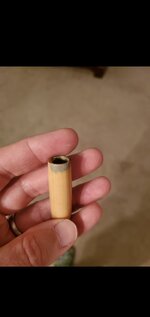You are using an out of date browser. It may not display this or other websites correctly.
You should upgrade or use an alternative browser.
You should upgrade or use an alternative browser.
Water under CA finish, maybe?
- Thread starter Gabericks
- Start date
Signed-In Members Don't See This Ad
Signed-In Members Don't See This Ad
leehljp
Member Liaison
The gray is sanding dust from the bushings - mixed with the wet sanding wate,r and then soaking into the ends. As Ken wrote - seal the ends before sanding.
There are those who swear by wet sanding and those who do not. It is your choice, but those who do not - have as fine a finish as those who do. That said, there can be another problem that crops up with wet sanding - with darker woods, moisture under the CA making look like the CA is cloudy.
Look at this list in a search for the word "cloudy" . . . most caused by wet sanding:
And another trick to eliminate the metal sanding dust: TBC - Turning Between Centers in which the bushings are taken off before final sanding. The blank is turned to size, or sanded to size by measuring with calipers instead of sanding down to the bushings. IF you sand the bushings, by the time you make about 20 pens with those bushings, the bushings will probably be 1/64" or more smaller, making it unsuitable for "sizing".
Below is an old link but still relevant concerning things pen turners wished they had known earlier:
BTW, concerning sanding - Ken and a few others here have eliminated sanding for the most part. If one is adapt at sharpening HSS tools, OR using good Carbide inserts, with a little practice, the blanks can be turned smooth, very smooth without the need for sanding. That is almost a necessity if doing certain kinds of segments.
There are those who swear by wet sanding and those who do not. It is your choice, but those who do not - have as fine a finish as those who do. That said, there can be another problem that crops up with wet sanding - with darker woods, moisture under the CA making look like the CA is cloudy.
Look at this list in a search for the word "cloudy" . . . most caused by wet sanding:
And another trick to eliminate the metal sanding dust: TBC - Turning Between Centers in which the bushings are taken off before final sanding. The blank is turned to size, or sanded to size by measuring with calipers instead of sanding down to the bushings. IF you sand the bushings, by the time you make about 20 pens with those bushings, the bushings will probably be 1/64" or more smaller, making it unsuitable for "sizing".
Below is an old link but still relevant concerning things pen turners wished they had known earlier:
If I had known this earlier . .
I am on a fact finding mission. Can you help? What do you wish you had known earlier in pen turning? or in different words: Knowing what you know now - IF you could go back and start over in pen turning - what would you skip, change or do differently? answers for instance: - I wish...
www.penturners.org
BTW, concerning sanding - Ken and a few others here have eliminated sanding for the most part. If one is adapt at sharpening HSS tools, OR using good Carbide inserts, with a little practice, the blanks can be turned smooth, very smooth without the need for sanding. That is almost a necessity if doing certain kinds of segments.
Last edited:
1080Wayne
Member
The colour change leaves me wondering if you sanded some steel bushing dust onto the wood , before applying any CA .
Hank beat me to it .
Hank beat me to it .
Gabericks
Member
Suggestions. Thank you so much. What method do you typically use to face down?
I use a disc sander now. In the past, I used a pen mill, but they can cause a lot of damage in a hurry, especially on segmented blanks. This is another topic that some have strong opinions on. I have settled on the disc sander method, haven't torn up a blank since.

